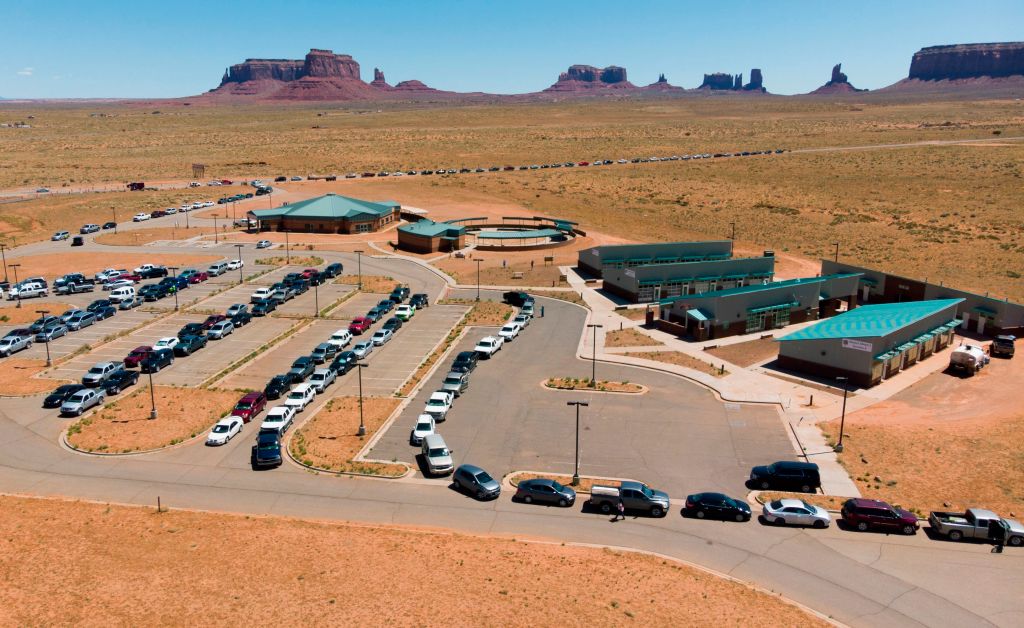IHS has delivered billions in water and waste projects to tribal lands. This engineer made it happen

Long before Lt. Cmdr. Melissa de Vera began her climb up the Indian Health Service management ladder, she and her sister would come home from school and be greeted with a note of caution from their mother taped to the front door of their apartment in Fallon, Nev.
“Don’t drink the water today,” de Vera recalled those notes warning. “The arsenic levels are too high.”
Known as both “the oasis of Nevada” and the “arsenic capital of America,” Fallon had amounts of the chemical element in its drinking water that significantly exceeded maximum containment levels, eventually leading to federal action.
As a kid, de Vera didn’t think a ton about the perilous state of her hometown’s drinking water — but she has no doubt that her upbringing “triggered” an interest in water that she made into a career. And it paved the way for her instrumental work on IHS’s Sanitation Facilities Construction Program and the $3.5 billion in projects the agency is delivering under the 2021 bipartisan infrastructure law.
For those efforts, de Vera will be one of 12 federal government workers honored Sunday with a Flemming Award, which has recognized excellence in public service for 76 years. She’ll join the ranks of Neil Armstrong, Dr. Anthony Fauci, Elizabeth Dole and others as a Flemming honoree.
As a “public service-driven” individual, de Vera said, “you get a little embarrassed” by the recognition. “It’s like, ‘oh great!’ And then, ‘oh no!’ But I’ve since convinced myself that … this is something to be very, very proud of. … This award really represents … the work of everybody else that’s been involved.”

The stage was set for de Vera’s work on improving access to safe drinking water and sanitary waste disposal infrastructure for American Indian and Alaska Native populations decades ago, when she worked as an operations clerk at a daycare at the local Navy base, beginning her lengthy career in public service.
She moved from there to a voucher examiner position at Fallon’s Naval Strike Air Warfare Center, where she rubbed shoulders with helicopter pilots armed with engineering degrees who convinced her to follow suit.
After earning a bachelor’s degree in environmental engineering at the University of Nevada-Reno in 2012, de Vera chatted with engineers in IHS’s Phoenix office thanks to a connection through her cousin, who also worked at the agency. A member of the Rocky Boy Chippewa Cree Tribe, de Vera was sold on the IHS engineering vision.
“I was really just drawn to water,” she recalled. “I spoke with them about the type of work that engineers do in the Indian Health Service, specifically in the division of Sanitation Facilities Construction. Everything just started to click from there.”
Now based in Bemidji, Minn., de Vera has been with IHS for more than 13 years, including the past two as assistant director for the agency headquarters’ division of Sanitation Facilities Construction (SFC). And it’s largely in that role that she’s been able to help tribal communities — like the one her family comes from in Montana — have better access to clean drinking water.
The SFC unit was tasked in 2021 with distributing the $3.5 billion allocated to IHS via the Infrastructure Investment and Jobs Act over five years. The challenge facing de Vera in helping IHS see that project through was a chronic vacancy rate at the Department of Health and Human Services component — meaning not enough engineers to do the work.
So began her quest to recruit and retain engineers. Her multifaceted strategy included partnering with the Department of Energy’s ORISE program to tap into a more robust STEM talent pipeline, hosting and mentoring students during summer engineering experiences, and leveraging IHS scholarships for Native American students. Those scholarships offer $50,000 in loan repayment for a two-year commitment, placing students in “harder-to-fill locations” and also offering extension options.
Other tactics de Vera pursued included a partnership with the U.S. Public Health Service Commission Corps and an overarching recruitment strategy to narrow the pool of potential candidates, casting a net not quite as wide in favor of targeted recruiting (for example, focusing more on civil and environmental engineers and less so on electrical or computer engineers). de Vera said her own technical background was helpful in approaching recruiting in that more data-driven way.
“We’re such a mission-driven division,” she said, so “we’re really helping people figure out, ‘is this your path? Is this your mission? Is this work that’s going to be meaningful for you?’ … If we target people correctly, and if we get the right message out there about our work, [we can show candidates] how great it is to actually be a federal engineer.”
Thanks to de Vera’s leadership in partnerships and recruiting, IHS has completed 1,077 water, sewer and solid waste projects, spending over $3.3 billion so far. The program operates on advanced appropriations, so the remaining dollars cannot be rescinded and will be spent.
As she accepts her Flemming prize Sunday, de Vera will be thinking of “the whole community” surrounding her that made it possible for her to win the award, as well as those who supported her when she quit her job at 33 to pursue her undergraduate engineering degree full time. She feels grateful to have found engineering and federal work, and hopes to continue helping others who are “driven to serve.”
“It’s never too late. I started my education way late in life,” she said. “It’s been such a positive experience. … If [someone’s] purpose is public service, [I’d encourage them to] find a way to make it happen.”




